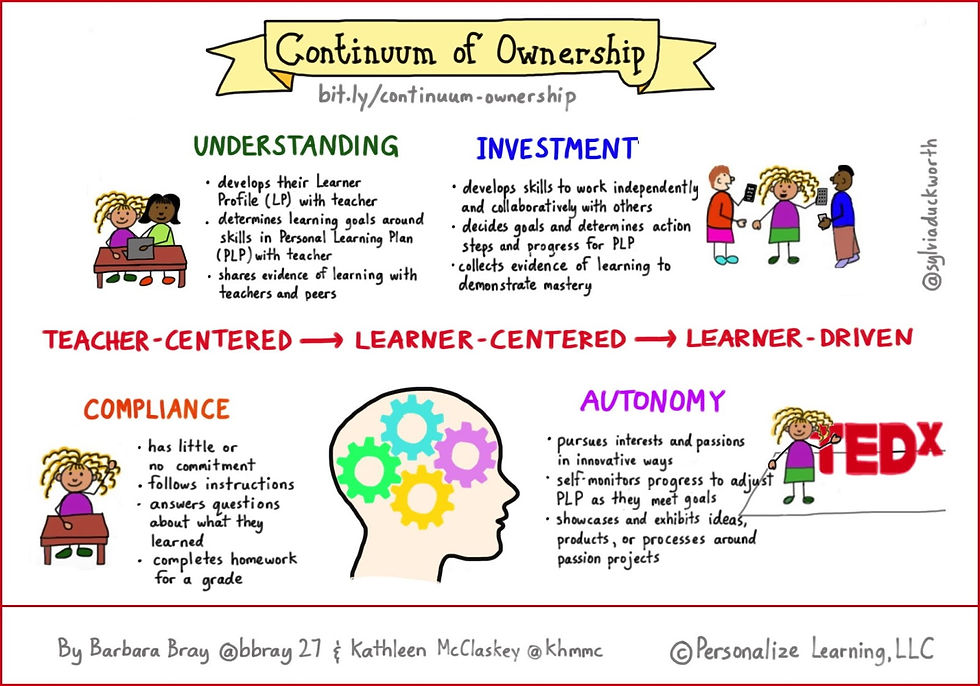Take Your OWNership
- Admin

- Oct 23, 2017
- 3 min read

The 21st century is an exciting time to be in the field of education. Dr. Harapnuik (2015) states in his Creating Significant Learning Environments video, “There has never been a better time to be a learner.” With Creating Significant Learning Environments (CSLE) through project-based learning, concept-based learning, technology, and COVA, learners are able to learn in environments that are student-centered, engaging, effective, flexible, and authentic. Dr. Harapnuik (2015) challenges teachers with the questions, “Are we teaching today’s students as we taught yesterday’s? Are we robbing them of tomorrow?” In today’s technologically-advanced world where teachers are expected to prepare students for jobs that may not even exist yet, we need to ensure that we are challenging students in effective learning environments. One way to meet this challenge is with the ePortfolio.
According to Campbell (2009), the cyberinfrastructure gives students the opportunity to learn beyond the walls of the classroom. “Students with this kind of digital fluency will be well-prepared for creative and responsible leadership in the post-Gutenberg age. Without such fluency, students cannot compete economically or intellectually, and the astonishing promise of the digital medium will never be fully realized” (p. 59). The ePortfolio is a cyberinfrastructure that gives students the opportunity to grow and learn under their own terms in ways that will meet and exceed the expectations of today and tomorrow.
In the evolving world of the cyberinfrastructure and ePortfolio, the debate of ePortfolio ownership is at the forefront. Can a student claim authentic ownership of the ePortfolio if its contents are contrived from course projects? Andrew Rikard (2015) states that, “Gaining ownership over the data is vital—but until students see this domain as a space that rewards rigor and experimentation, it will not promote student agency. Traditional assignments don’t necessarily empower students when they have to post them in a public space” (para. 5). It is not about completing a regular class assignment and then posting it online, but rather building something of your own. Being told everything to put on your digital domain makes it a digital file of course content, not a reflection of whom you are as a teacher and learner. Students need to view the ePortfolio as their own place to find their voice and take risks.

However, including projects that are assigned in courses is not a negative aspect of the ePortfolio either. According to Watters (2015), “Students have control over the look and feel of their own sites, including what’s shared publicly. This means they have some say — although not complete — over their personal data, and in turn they begin to have an understanding of the technologies that underpin the Web, including how their work and their data circulate there” (para. 7). Just because a professor gives you an idea of what topic to cover for a certain project does not mean that it is an inauthentic, contrived idea. Using COVA, each component of the ePortfolio should be an accurate reflection of the student, giving that student ownership.
Who owns the ePortfolio? In short, the student owns the ePortfolio IF the student takes ownership of it. Like many things in this world, ePortfolios are what you make them. Doing minimal ePortfolio development to pass a course will not give you ownership, but using the ePortfolio to evolve your identity as a teacher and learner will.
References
Campbell, G. (2009). A Personal Cyberinfrastructure. EDUCAUSE Review: New Horizons, 58-59. Retrieved from https://luonline.blackboard.com/bbcswebdav/pid-176874-dt-forum-rid-15918026_1/courses/EDLD_5303_D03_2016_10_AP2/A%20Personal%20Cyberinfrastructure-ERM0957.pdf
Harapnuik, D. (2015, May 08). Creating Significant Learning Environments (CSLE) [Video File]. Retrieved
from https://www.youtube.com/watch?v=eZ-c7rz7eT4
Rikard, A. (2015, August 10). Do I Own My Domain If You Grade It? Retrieved October 23, 2017, from
https://www.edsurge.com/news/2015-08-10-do-i-own-my-domain-if-you-grade-it
Watters, A. (2015, July 15). The Web We Need to Give Students. Retrieved October 23, 2017, from
https://brightreads.com/the-web-we-need-to-give-students-311d97713713




















Comments